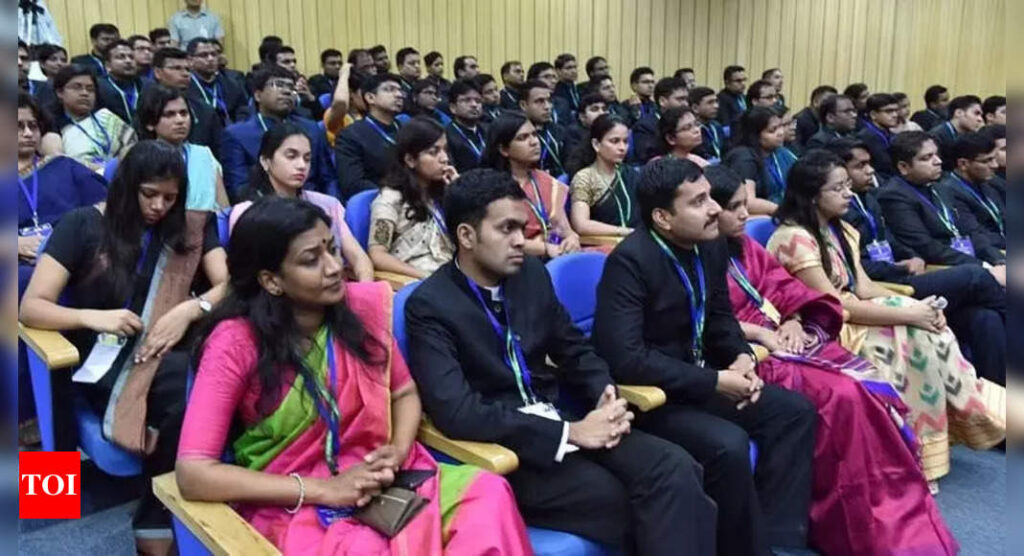Clearing the UPSC IAS exam is one of the greatest accomplishments in a UPSC aspirant’s life, and becoming an IAS officer is a great opportunity to serve the nation and make a positive impact on society.
Many of us dream of becoming an IAS officer but have you ever wondered what is the process after clearing the UPSC exam? Shortlisted 180 IAS candidates are called the Officer Trainees (OTs) who aim at overall personality development and technical upskilling during their learning phase before stepping into the main field as an IAS officer and joining their respective cadres and services.
The initial phase for shortlisted candidates is a four-month Foundation Course at the Lal Bahadur Shastri National Academy of Administration (LBSNAA) in Mussoorie, Uttarakhand. After the completion of this course, the OTs are divided as per the services and are sent to the designated places for training. However, the training for the IAS officers is conducted at LBSNAA which includes Bharat Darshan (a tour of India) and District training.
The newly selected 180 IAS officers undergo an extensive training program at the Lal Bahadur Shastri National Academy of Administration (LBSNAA). The training program is designed in a way and pattern so that it helps the IAS officers to equip with the essential skills and knowledge to efficiently carry out their roles as administrators.
During their training at LBSNAA, the fresh recruits attend different lectures and workshops on topics like Indian Constitution, public policy, governance, administrative law, and management. They also participate in field visits, group discussions, case studies, and simulations to gain practical experience in managing public affairs.
Apart from the academic and practical training, the training program at LBSNAA also involves developing the IAS officers’ overall personality, communication skills, and leadership qualities. The officers are encouraged and motivated to participate in various extracurricular activities like cultural events, sports, and community service to bring up a sense of camaraderie and social responsibility among them.
At LBSNAA, there are teaching facilities, living accommodations, a sports complex, a library, a dispensary, IT services, an officers’ mess, internet services, etc. The newly constructed Aadharshila and Gyanshila buildings at the LBSNAA have faculty and staff offices, lecture halls, and computer rooms. Sampoornanand Auditorium is the largest central hall that hosts cultural events and functions. Indira Bhavan campus which is about 1 KM from the main campus is used for short-term programs.
The academy also allocates a helper to differently-abled trainees on campus on a requirement basis to help them to perform their day-to-day activities.
Overall, the Foundation Course at LBSNAA aims to prepare the IAS officers to become strong and efficient administrators who can lead and manage government initiatives to improve the lives of the people across the country or whom they serve.
Many of us dream of becoming an IAS officer but have you ever wondered what is the process after clearing the UPSC exam? Shortlisted 180 IAS candidates are called the Officer Trainees (OTs) who aim at overall personality development and technical upskilling during their learning phase before stepping into the main field as an IAS officer and joining their respective cadres and services.
The initial phase for shortlisted candidates is a four-month Foundation Course at the Lal Bahadur Shastri National Academy of Administration (LBSNAA) in Mussoorie, Uttarakhand. After the completion of this course, the OTs are divided as per the services and are sent to the designated places for training. However, the training for the IAS officers is conducted at LBSNAA which includes Bharat Darshan (a tour of India) and District training.
The newly selected 180 IAS officers undergo an extensive training program at the Lal Bahadur Shastri National Academy of Administration (LBSNAA). The training program is designed in a way and pattern so that it helps the IAS officers to equip with the essential skills and knowledge to efficiently carry out their roles as administrators.
During their training at LBSNAA, the fresh recruits attend different lectures and workshops on topics like Indian Constitution, public policy, governance, administrative law, and management. They also participate in field visits, group discussions, case studies, and simulations to gain practical experience in managing public affairs.
Apart from the academic and practical training, the training program at LBSNAA also involves developing the IAS officers’ overall personality, communication skills, and leadership qualities. The officers are encouraged and motivated to participate in various extracurricular activities like cultural events, sports, and community service to bring up a sense of camaraderie and social responsibility among them.
At LBSNAA, there are teaching facilities, living accommodations, a sports complex, a library, a dispensary, IT services, an officers’ mess, internet services, etc. The newly constructed Aadharshila and Gyanshila buildings at the LBSNAA have faculty and staff offices, lecture halls, and computer rooms. Sampoornanand Auditorium is the largest central hall that hosts cultural events and functions. Indira Bhavan campus which is about 1 KM from the main campus is used for short-term programs.
The academy also allocates a helper to differently-abled trainees on campus on a requirement basis to help them to perform their day-to-day activities.
Overall, the Foundation Course at LBSNAA aims to prepare the IAS officers to become strong and efficient administrators who can lead and manage government initiatives to improve the lives of the people across the country or whom they serve.

